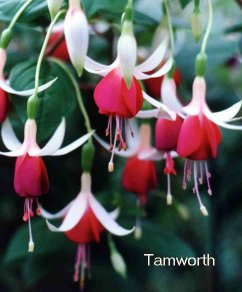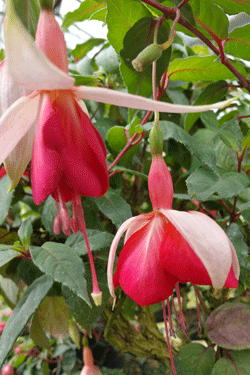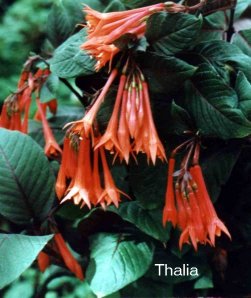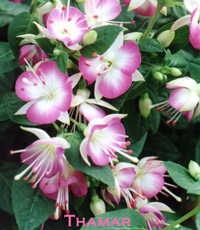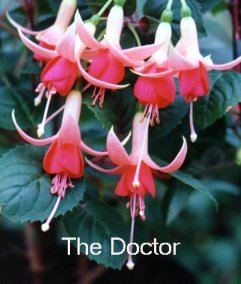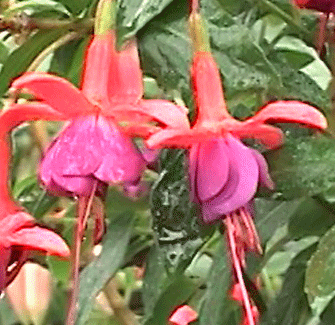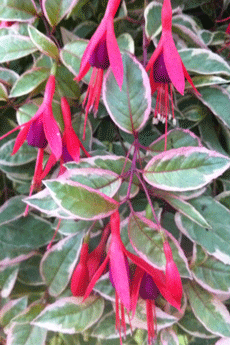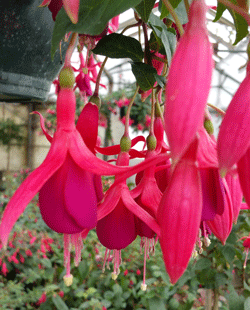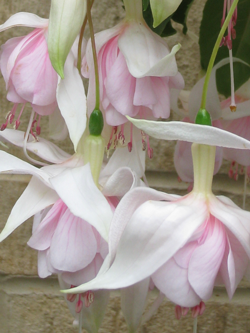|
|
T |
|
|
|
|
|
Taffeta Bow. 1974 (Stubbs). Double. Tube and Sepals carmine-rose. Sepals broad and long of crepe texture, curving like a bow. Corolla pale violet-purple with pink splashes. Growth natural trailer with huge blooms. |
|
|
|
|
Tamworth. 1976 (Handley). Single. Tube and Sepals crisp, pure white tipped green. Corolla rich purple at outer edge changing to band of salmon-pink, then to white near tube. Medium sized flowers, early and prolific. Growth upright bush, easy to shape. |
|
|
|
|
Tangerine. 1949 (Tiret). Single. Tube flesh pink. Sepals pale green. Corolla orange, ageing to rose. Flowers longish, free. A lovely showy bloom. Grows strong upright bush. |
|
|
|
|
Temptation. 1959 (Peterson). Single. Tube and Sepals white. Corolla orange rose, flushed white. Flowers medium, profuse. Grows upright. |
|
|
|
|
Tennessee Waltz. 1950 (Walker and Jones). Double. Tube and Sepals rose madder. Corolla rosy-mauve, squarish with centre points on petals. Flowers medium, free. Grows strong upright bush. Excellent for standards. |
|
|
|
|
Thalia. 1855 (Turner). Single. Rich orange scarlet self. Tube long. Sepals and corolla small. Flowers long, free, borne in terminal clusters. Rich bronze-green foliage. Another hybrid of triphylla type. Grows upright bush. |
|
|
|
|
Thamar. 1987 (Springer) Single. Tube and Sepals white. Corolla lavender/mauve, white at base. Exquisite small blooms held upright. Exceedingly floriferous. Dark green foliage. Strong upright growth. Suitable for show work. |
|
|
|
|
The Doctor. (British). Single. Tube longish. Sepals flesh-pink, recurving. Corolla rosy-salmon. Flowers freely, medium size. Clear cut colour combination. Growth lax. Good for standard or even basket. Excellent grower. |
|
|
|
|
Three Cheers. Single. Tube and Sepals palish red, upturned. Corolla white shading to deep violet blue at base. This fuchsia is truly red, white and blue. Very showy. |
|
|
|
|
Time After Time. 2006 Single. Sepals rose pink tipped green. Corolla pale pink. Very free flowering. |
|
|
|
|
Ting a Ling. 1959 (Schnabel). Single. Pure white. Can only be described as being a white "Display" with all the latter's excellent points. |
|
|
|
|
Tom Thumb. (Hardy) 1850 (Baudinat). Single. Sepals scarlet. Corolla mauve. Small flowers very freely produced, ideal for rock gardens. Extremely compacAt plant. 1½-2ft (45-60cm). |
|
|
|
|
Tom West. 1853 (Meillez). Single. Tube and Sepals red. Corolla purple. Small flowers, grown mostly for its variegated foliage of cream and pale green. Grows compact bush, short jointed. |
|
|
|
|
Trail Blazer. 1951 (Reiter). Double. Tube and Sepals palish-magenta. Corolla dark magenta. Flowers very large and long, fairly free. Sepals and Corolla very long. Grows cascade. |
|
|
|
|
True Love. New 2018 (Gerald Blackwell) Double. Tube and Sepal white. Corolla pale pink veined pink. Lax bush. Highly recommended extremely vigorous. Very versatile can be trained into any shape. |
|
|
|
|
Trumpeter. 1946 (Reiter). Geranium lake self. Flowers long. A triphylla hybrid. Rich blue-green foliage. |
|
|
|
|
Tuonela. 1968 (Blackwell). Double. Tube and Sepals pinkie blue. Corolla powder blue. Sometimes spoken of as a blue fuchsia. |
|
|
|
PLEASE NOTE FOR WINTER MONTHS: H.1. requires greenhouse heated to minimum of 40°F (4.5°C). Although the above classifications are our recommendations, many of our customers are growing fuchsias that we classify as H.2 out of doors with good results and obviously with bigger blooms produced on H.2's than on The RHS and the British Fuchsia Society list many fuchsias that we classify as H2 medium hardy, as H3 hardy and with the climate changes (Global warming) this has probably become a fact |
|
|
|
A B C D E F G H I J K L M N O |
|||


